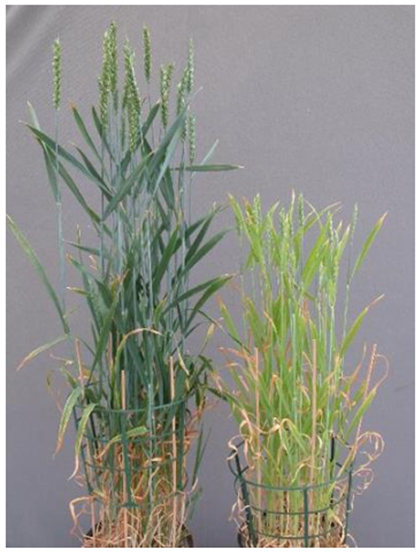The fourth major plant nutrient
Sulphur makes up approximately 3% of the Earth's mass and is the thirteenth most abundant element in the Earth's crust. When it comes to arable and grassland agriculture, its importance has been well publicised and documented since the 1970s.
Why is the availability of sulphur a problem?
The low levels of sulphur we see today are not a new problem. Rather, it is something we've been aware of for over 30 years; ever since the first sulphur-deficient oilseed rape crops were seen on very light soils. Over time, this deficiency has progressed and now impacts virtually all crops and soil types.
The reason that we see these deficiencies is simply down to the dramatic, ongoing reduction in sulphur dioxide emitted into the atmosphere from all industrial and transport sources. Historically, when there was ample sulphur dioxide being released it would be absorbed and returned to the ground through rain, thereby supplying valuable nutrition to our crops.
This reduction was most dramatic from the mid-1990s through to 2010 (as a result of the Clean Air Act) but it has still declined further over the last 10 years, as demonstrated in figures 1 and 2 which show 2010 and 2020 values. From the data, it is clear that the current, natural deposition of sulphur does not meet today's crop requirements.
Maps of monthly dry deposition projected on the 5km OSGB projection for 2010 & 2020
Figures from a recent Department for Environment, Food and Rural Affairs (DEFRA) report show that at least 30% of combinable crops and 55% of grassland are not receiving the amount of sulphur needed to meet the shortfall between crop requirement and the sulphur supplied by atmospheric deposition and natural mineralisation. Of course, today's growers and land managers are well aware of the importance of sulphur, but the impact of this shortfall should also be considered.
As already mentioned, we need to consider that the range of crops and soil types affected has increased and will only persist as the deposition continues to decline. If we look back at the high amounts of rainfall this autumn and winter, this caused a large amount of nutrient (nitrogen and sulphur) to be lost via leaching or run off. Unfortunately, this increased the risk of deficiency even further.
Where are we likely to see a deficiency?
Sulphur behaves very much like nitrogen and is easily leachable, so we are more likely to see a deficiency in lighter, sandy soils, but with sufficient rainfall all soils can be affected. With this in mind, we must be aware of excess winter rainfall affecting sulphur, much the same as we are with nitrogen. You can find more information about the excess winter rainfall we had this year on the Agriculture and Horticulture Development Board (AHDB) website: https://ahdb.org.uk/ewr.
The uptake of sulphur by plants increases rapidly during spring growth as the crop takes up nitrogen and, as a result, any deficiency will become visible from mid-to-late March onwards. Sadly, this year there were some reports from around the country of crops suffering from lack of sulphur. With this in mind, it's advisable that you have a fertiliser plan in place for next spring to ensure a sufficient supply of sulphur to all your crops.
What is the appropriate amount of sulphur?
The amount required is dependent on the crop, soil type and amount of rainfall. This is because crop demand varies, lighter soils will leach more, and rainfall increases leaching. Table 1 gives guidance on the recommended amounts for the main arable crops.
If we look at intensive grassland, particularly that used for silage, sulphur is also crucial. An application of 40kgs/ha SO3 per cut will satisfy this requirement.
When should you apply the recommended amounts?
Crop demand for sulphur happens at a similar time to nitrogen, so it ideally needs to be applied with each nitrogen application. However, the choice of products available and the varying requirements of different crops can make this very difficult to achieve. Applying all the sulphur early in February, for example, does work but it runs the risk of shortfalls later in the season if any is lost through leaching. Either slightly over-apply to account for this or start your programs with a low dose of straight nitrogen followed soon afterwards with all the sulphur.
How can we deliver sulphur and what are your options?
Sulphur can only be taken up by plants from the soil as sulphate, so as long as it is made available in fully water-soluble sulphate form, the material will be immediately available for crop uptake. Importantly though, while there are many different sulphur products on the market to meet your crops' requirements, some might not suit every situation. For example, the quality of granules can differ and although all options should be good enough to spread up to 24m, some products will struggle at wider distances, especially past bout widths of 30m.
Another important consideration is the amount of sulphur in relation to nitrogen. High sulphur products with very little nitrogen should be used first, such as ammonium sulphate. Unless you significantly over-apply sulphur, using it will often mean an extra separate nitrogen application has to be added to the programme, questioning the suitability of this product. The run of recent dry springs has compounded this further, as growers look to apply more nitrogen in their first applications to reduce the amounts in subsequent passes. This very much suits lower sulphur grades like CF SingleTop, Yara Axan and especially CF Sulphur Gold, where the nitrogen can be increased without over-applying sulphur.
CF Sulphur Gold & Yara Sulphan 24
An ideal ratio for first applications in the cereal programme and the first two applications of a three-split programme in OSR.
CF SingleTop
Best for the first two applications in cereals and all the way through an OSR programme.
Yara Axan
Good for the first two applications in cereals but does not potentially apply enough sulphur in OSR.
Liquid NS Grades
Great for applying sulphur 'little and often' all the way through the fertiliser programme for all crops.
Polysulphate, PotashpluS and PKpluS
A way to decouple nitrogen and sulphur, allowing for a completely flexible nitrogen programme.
Overall, I am not recommending that we significantly increase sulphur applications (unless you are not currently applying any sulphur fertiliser at all) or to stop purchasing a certain product overnight. My advice is to really consider the options you have available in relation to your circumstances; that way you can make informed decisions and opt for products that match your crops' sulphur demand.
Doing so can improve efficiency too. The right product in combination with the right rates can lead to fewer passes, accurate applications even at wide bout widths, and greater versatility in terms of the amount of nitrogen applied with the sulphur. The time taken to effectively plan can bring multiple benefits, whether you're in a high yielding season and simply want to help your crops reach their full yield potential, or you want to support a crop in challenging conditions.
For advice on anything mentioned above or if you'd like more information, please speak to your local Frontier contact or get in touch.
As a subscriber, you’ll receive email alerts each time a new blog is published so you can always stay updated with the latest advice and insights from our experts











Comments